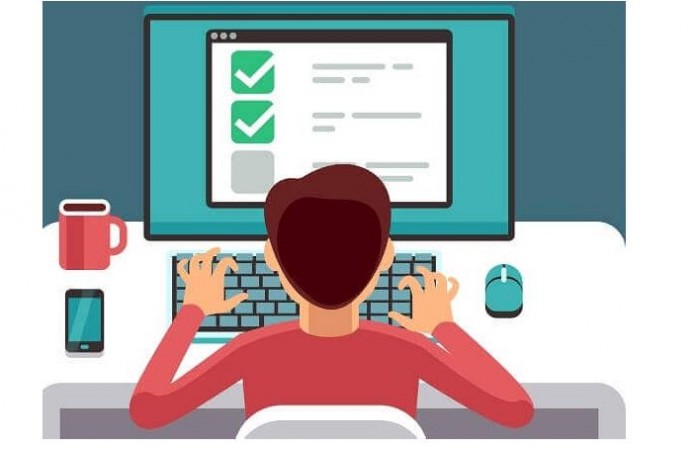
The appeal of digital schooling is undeniable, but it comes with a number of challenges and drawbacks. Students and parents who receive this type of schooling are more likely to be concerned. The vast majority of these issues are around the quality of education and its outcomes in comparison to traditional modes of learning. Everyone is concerned about a lack of motivation and a practical approach to education, as well as the lack of direct monitoring during exams or tests. Cheating becomes easy without direct invigilation, making the outcome of such a degree doubtful.
These concerns are no longer a barrier to distant education, thanks to remote exam proctoring software. The primary and exclusive purpose of such remote exam proctoring software is to prevent any and all cheating actions during tests and exams conducted from a remote location without human invigilation. The single duty performed by such online remote proctoring software directly or indirectly addresses all issues about distance education.
What is an Online Proctored Examination?
Companies and institutes have employed online assessments for many years, but they have never been considered on par with traditional examinations. However, as ed-tech solutions evolved and online tests were more widely used, the demand for online proctoring increased. One of the primary causes is a lack of effective malpractice prevention procedures.
Furthermore, there was no way to tell whether the learner was copying the answers by looking at several websites or a book. As a result, remote proctoring software is the ideal choice for instilling a sense of authority and encouraging pupils to observe rules. Furthermore, proctors can watch these exams from a remote place.
In addition, institutes can use various sorts of remote proctoring techniques based on their needs. For example, image-based, audio-based, and video-based proctoring are among the most used ways. Furthermore, these strategies are very effective when creating hybrid classroom sessions.
Teachers can enable online tests or activities in hybrid classroom sessions, and the proctoring software allows them to closely monitor student activity.
Different Types of Remote Proctoring
It is fair to say that most students have a love/hate relationship with exams; you can sense their anxiousness and palpitations when the tests are only a few weeks or months away. Furthermore, an exam-centric strategy has long served as the foundation of the educational system. Teachers assessed exam response sheets with care and precision, taking a lot of time and effort.
Image-based Proctoring
Internet bandwidth or internet connection is not always consistent, particularly for students living in rural locations where a reliable internet connection is uncommon. Furthermore, rural education has lagged due to insufficient government assistance and a lack of infrastructure. Such limits should not hinder pupils from obtaining an education.
As a result, NEP 2020 is a revolutionary project that offers equal educational chances for children from diverse socioeconomic backgrounds. Furthermore, the policy includes guidance for integrating ICT and enhancing basic facilities for schoolchildren.
It would greatly help to facilitate comprehensive online proctored tests; nevertheless, if connectivity challenges persist, schools can use image-based proctoring. Furthermore, image-based proctoring is effective in places with limited internet connectivity, where other proctoring methods may fail.
Audio-Based Proctoring
Audio-proctoring is the most recent innovation in proctoring technology and one of the most successful methods. Furthermore, it occurs when the microphone searches the exam takers' physical surroundings for additional noises. As a result, it aids in distinguishing between sounds that may or may not be present in the test setting.
Furthermore, audio proctoring software uses the exam-taking candidate's microphone to detect subtleties such as whispers, mumbling, low sound levels, and so on. In truth, it is a great AI-powered feature that can distinguish between candidate audio and background noise. For example, it can identify strange noises or discussions that indicate cheating.
When the technology detects such noises, it sends a warning and displays a statement indicating malpractice.
Video-Based Proctoring
Video-based proctoring is the most often utilized technique in schools, colleges, and universities. It can be used in two ways: live-streamed and recorded exams, both of which discourage cheating. The former allows the examiner to watch student activities in real time and identify any suspect activity.
On the other hand, recorded exams are another type of online proctored exam in which the program records the entire examination. As a result, the examiner or invigilator monitors the saved feed in the cloud for any suspicious activity. If they discover any evidence of unethical behavior, they flag the student examination and forward the information to the appropriate stakeholder.
Candidate Authentication
Students frequently take advantage of the lack of adequate safeguards and use unethical tactics to pass their tests. Furthermore, institutes faced a continuous challenge with student identification. There was no way to know if the student taking the test was the person they claimed to be.
Furthermore, there have been cases of proxy attendance; hence, AI (Artificial Intelligence) has proven to be beneficial for online examinations. Furthermore, AI-powered approaches like face recognition make excellent use of AI algorithms to analyze students' facial characteristics. Furthermore, it compares them to pre-registered photos to verify the exam taker's identity.
It is an effective approach for preventing imitation and ensuring the integrity of the exam. Similarly, object-detection technology, such as smartphones, employs the same algorithm to recognize and track items in the student's environment. When the gadget detects such devices, it sends a message instructing the student to remove any illegal objects.
Finally, chatbots are essential for distant proctoring and in online proctoring software since they use AI-powered software programs to establish discussions. In effect, it offers pupils real-time support and help during the exam. For example, students can utilize the chatbot to request assistance if they encounter technological faults or logistical issues.
The Online Examination System has evolved into a standardized assessment system that enables teachers to evaluate student learning. However, Merce r |Mettl allows performing them with proper as well as enough technological backing. That is why online proctoring software is a crucial tool for authenticating the examination procedure.